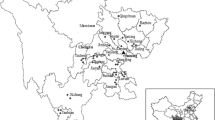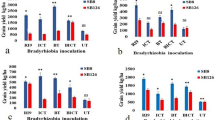Abstract
Bradyrhizobium strains were isolated from nodules obtained from field-grown soybean plants sampled in 12 soybean production locations in Argentina. These fields had been annually cropped with soybean and did not show decreases in yields even though they had been neither N-fertilized nor inoculated for at least the last 5 years. We hypothesized that the isolated strains maintained high competitiveness and efficiency in fixing adequate N2 levels. A set of strains that showed the highest nodular occupancy in each sampling location were assayed for symbiotic performance under greenhouse and field conditions and comparatively evaluated with Bradyrhizobium japonicum E109, the strain officially recommended for inoculant formulation in Argentina. An inoculant pool, formed by four strains obtained from nodules collected from Cañada Rica, developed higher nodular biomass than B. japonicum E 109 in assays carried out in greenhouses under well irrigated conditions. Additionally, neither nodule production nor specific nitrogenase activity decreased with respect to B. japonicum E 109 when plants were drought stressed during 7 days from sowing. The mean yields obtained under field conditions and plotted against the principal component one (CP1) obtained with an additive main effect and multiplicative interaction (AMMI) model showed that the inoculant pool from Cañada Rica had higher contribution to yield than strain E 109, although with lower environmental stability. The inoculant pool from Cañada Rica could be considered an improved inoculant and be used for preliminary assays, to formulate inoculants in Argentina.




Similar content being viewed by others
References
Allen ON, Allen EK (1981) The Leguminosae; a source book of characteristics, uses, and nodulation. Madison, WI, p 812
Arrese-Igor C, Gonzalez EM, Gordon AJ, Minchin FR, Galvez L, Royuela M, Cabrerizo PM, Aparicio-Tejo PM (1999) Sucrose synthase and nodule nitrogen fixation under drought and other environmental stresses. Symbiosis 27:189–212
Batista JSS, Hungria M, Gomes Barcellos F, Cristiani Ferreyra M, Carvalho Mendes I (2007) Variability in Bradyrhizobium japonicum and B. elkanii seven years after introduction of both the exotic microsymbiont and the soybean host in a Cerrados soil. Microb Ecol 53:270–284
Berg RK, Loynachan TK, Zablotowicz RM, Lieberman MT (1988) Nodule occupancy by introduced Bradyrhizobium japonicum in Iowa soils. Agron J 80:876–881
Bhagwat AA, Keister DL (1992) Identification and cloning of Bradyrhizobium japonicum genes expressed strain selectively in soil and rhizosphere. Appl Environ Microbiol 58:1492–1495
Brockwell J, Gault RR, Zorim M, Roberts MS (1982) Effects of environmental variables on the competition between inoculum strains and naturalized population of R. trifolii for nodulation of Trifolium subterraneum L. and on Rizobia persistence in the soil. Aust J Agr Res 33:803–815
Date RA (2000) Inoculated legumes in cropping systems of the tropics. Field Crop Res 65:123–136
Di Rienzo JA, Casanoves F, Balzarini MG, Gonzalez L, Tablada M, Robledo CW (2009) InfoStat versión. FCA, Universidad Nacional de Córdoba, Argentina, Grupo InfoStat
Fehr WR, Caviness CE (1977) Stages of soybean development Special Rep. 80. Iowa State University, Ames Iowa, p 11
Gauch HG (1988) Model selection and validation for yield trials with interaction. Biometrics 44:705–715
Gomes Barcillos F, Menna P, da Silva Batista JS, Hungria M (2007) Evidence of horizontal transfer of symbiotic genes from a Bradyrhizobium japonicum inoculant strain to indigenous diazotrophs Sinorhizobium (Ensifer) fredii and Bradyrhizobium elkanii in a Brazilian Savannah Soil. Appl Environ Microbiol 73:2635–2643
Graham PH (1992) Stress tolerance in Rhizobium and Bradyrhizobium and nodulation under adverse soil conditions. Can J Microbiol 38:475–484
Ham GE (1980) Inoculation of legumes with Rhizobium in competition with naturalized strains. In: Newton W, Orme-Johnson W (eds) Nitrogen fixation, vol II, University Park Press. Baltimore, MD, pp 131–138
Hardy RWF, Holsten RD, Jackson EK, Burns RC (1968) The acetylene—ethylene assay for N2 Fixation: Laboratory and field evaluation. Plant Physiol 43:1185–1207
Howieson JG, Malden J, Yates RJ, O’Hara GW (2000) Techniques for the selection and development of elite inoculant strains of Rhizobium leguminosarum in southern Australia. Symbiosis 28:33–48
Marino D, Gonzalez EM, Arrese-Igor C (2006) Drought effects on carbon and nitrogen metabolism of pea nodules can be mimicked by paraquat: evidence for the occurrence of two regulation pathways under oxidative stresses. J Exp Bot 57:665–673
Martensson AM (1989) Competitiveness of inoculant strains of Rhizobium leguminosarum bv. trifolii in red clover using repeated inoculation and increased inoculum levels. Can J Microbiol 36:136–139
Montecchia M, Kerber N, Perticari A, Pucheu N, Garcia A (2004) Characterization of Bradyrhizobium isolates nodulating soybean from the northwest Argentine by rep-PCR genomic fingerprinting. In Jonas R, Pandey A and Tharum G. (Eds) Biotechnological advances and applications in bioconversions of renewable raw materials. Druckerei and Verlag, Braunschweig, Germany pp176-180 ISBN 3–925 268-25-0
Racca R (2009) Soja en siembra directa. Importancia de la FBN en cultivos y principales factores ambientales que la condicionan AAPRESID Revista Técnica. ISSN 1850-0633 pp 63–65
Rodriguez Blanco A, Sicardi M, Frioni L (2010) Competition for nodule occupancy between introduced and native strains of Rhizobium leguminosarum biovar trifolii. Biol Fertil Soils 46:419–425
SAGPyA (2007) Estimaciones agrícolas oficiales [on line]. http://www.sagpya.mecon.gov.ar/new/00/. [Accessed 22 August, 2007]
Serraj R, Sinclair T, Purcell R (1999) Symbiotic N2 fixation response to drought. J Exp Bot 50:143–155
Straliotto N, Gouvea Rumjanek R (1999) Aplicacao e evolucao dos metodos moleculares para o estudo da diversidade do rizobio. EMBRAPA- Doc 93. ISSN 0104–6187
Thies JE, Singleton PW, Bohlool BB (1991) Modeling symbiotic performance of introduced rhizobia in the field by use of indices of indigenous population size and nitrogen status of the soil. Appl Environ Microbiol 57:29–37
Yu-Li T, Olson BH (1992) Rapid method for separation of bacterial DNA from humic substances in sediments for polymerase chain reaction. Appl Environ Microbiol 58:2292–2295
Van Belkum A (1999) Short sequence repeats in microbial pathogenesis and evolution Cell. Mol Life Scie 56:729–734
Versalovic J, Schneider M, de Bruijn F, Lupski JR (1994) Genomic fingerprinting of bacteria using repetitive sequence-based polymerase chain reaction Methods Mol Cell. Biol 5:25–40
Vincent JM (1970) A manual for the practical study of root nodule bacteria. IBP handbook 15. Blackwell Oxford, United Kingdom
Zahran HH (1999) Rhizobium-legume symbiosis and nitrogen fixation under severe conditions and in an arid climate. Microbiol Mol Biol Rev 63:968–989
Zahran HH, Karsisto L, Lindstorm K (1994) Alteration on lypopolysacharides and protein profiles in SDS-PAGE of rhizobia by osmotic stress. World J Microbiol Biotechnol 10:100–105
Acknowledgments
The authors thank Dr. Mario Aguilar and his group (IBBM-CONICET, La Plata-Argentina) for their assistance in the use of GelCompar II software, and Dr. Cecilia Bruno for her assistance in statistical data analysis. MM and RL are CONICET researchers, RR is CONICET-INTA researcher, MdL and CL are INTA researchers, PS is INTA-technician, and GGA is manager of Rizobacter Argentina S.A. This work was partially supported by Rizobacter Argentina S.A.
Author information
Authors and Affiliations
Corresponding author
Rights and permissions
About this article
Cite this article
Melchiorre, M., de Luca, M.J., Gonzalez Anta, G. et al. Evaluation of bradyrhizobia strains isolated from field-grown soybean plants in Argentina as improved inoculants. Biol Fertil Soils 47, 81–89 (2011). https://doi.org/10.1007/s00374-010-0503-7
Received:
Revised:
Accepted:
Published:
Issue Date:
DOI: https://doi.org/10.1007/s00374-010-0503-7




